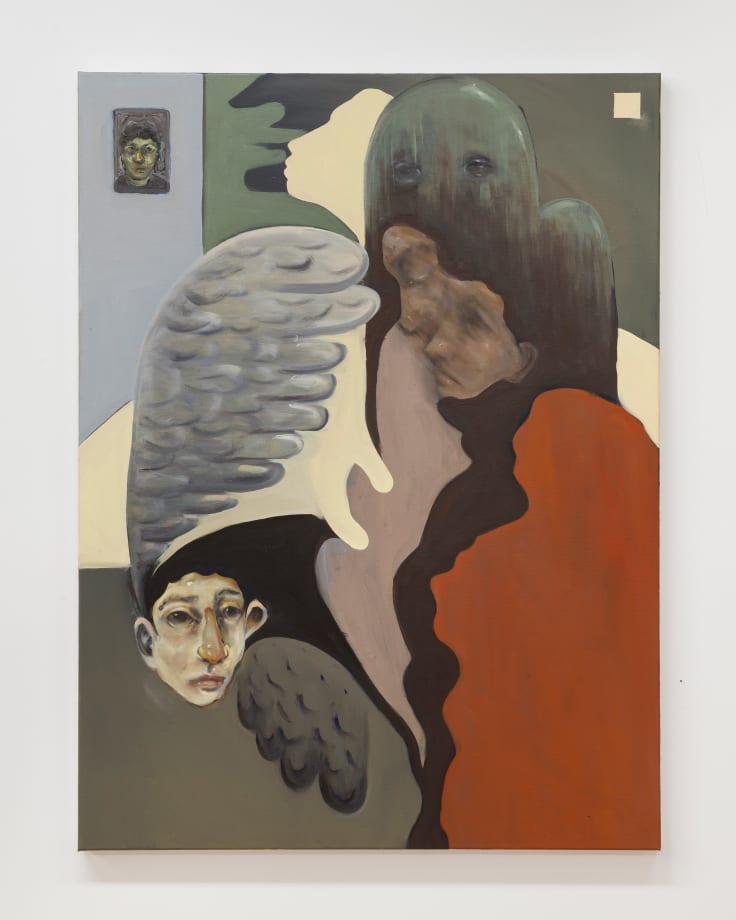The title of Robbie Motion’s latest exhibition is a tongue-in-cheek throwback to American television from the 1990s: specifically, a coming-of-age sitcom about a boy navigating the pitfalls of growing up and finding his place in the world. It’s tempting to interpret this pop-cultural reference as a cynical yet charming nod to the artist’s realisation that his own boyhood is now squarely in the rear-view mirror, with the realities of the world increasingly racing up the road to meet him. Or perhaps it’s simply an acknowledgement of Motion’s recent return from Europe to these little islands at the bottom of the Pacific. Whatever the case, BOY MEETS WORLD is characteristically both earnest and playful, and entirely in tune with the artist’s practice.
Following a degree in Art History, Film and Media at the University of Otago, Motion came to painting via creating artwork for album covers and posters for local Dunedin bands. Perhaps unsurprisingly then, his paintings exhibit a languid, distorted quality that is at once melodic and unsettling. Influenced by the work of Irish/British painter Francis Bacon, Motion's figures possess a certain vulnerability, with their limbs and faces distorted, obliterated, and overlapping.
Motion is adept at morphing and shifting between styles, forever seeking a wobbly point of tension through a simultaneous sense of push and pull. His work typically consists of a series of paintings within paintings; a discord of vignettes that come together to create a harmonious whole. Through this collage-like approach – hovering somewhere between figuration and abstraction – Motion manages to create contemplative spaces that exist alongside the corporeal, sometimes more or less explicitly, as in the inclusion of a window or an open door. Similarly, Motion has a way of collapsing time in his work; classicism, myth, modernism, and contemporary culture are muddied together in an oddly familiar and fluid way, like the faint memory of a half-forgotten dream.
I’ve met some of the worst people at the pub (2024) feels like a big night on the tiles. The table sticky with spilled drinks, air hazy with smoke, blurred faces lurching out of nowhere, limbs suddenly ungainly, and words slurred and slippery. The work speaks to that intoxicating hedonism of youth, and the desperate desire for distraction in the face of global economic, environmental,and societal collapse. Maybe the open door at the back of the canvas is a potential portal to escape, redemption, or perhaps most terrifying of all, the real world.
Following a degree in Art History, Film and Media at the University of Otago, Motion came to painting via creating artwork for album covers and posters for local Dunedin bands. Perhaps unsurprisingly then, his paintings exhibit a languid, distorted quality that is at once melodic and unsettling. Influenced by the work of Irish/British painter Francis Bacon, Motion's figures possess a certain vulnerability, with their limbs and faces distorted, obliterated, and overlapping.
Motion is adept at morphing and shifting between styles, forever seeking a wobbly point of tension through a simultaneous sense of push and pull. His work typically consists of a series of paintings within paintings; a discord of vignettes that come together to create a harmonious whole. Through this collage-like approach – hovering somewhere between figuration and abstraction – Motion manages to create contemplative spaces that exist alongside the corporeal, sometimes more or less explicitly, as in the inclusion of a window or an open door. Similarly, Motion has a way of collapsing time in his work; classicism, myth, modernism, and contemporary culture are muddied together in an oddly familiar and fluid way, like the faint memory of a half-forgotten dream.
I’ve met some of the worst people at the pub (2024) feels like a big night on the tiles. The table sticky with spilled drinks, air hazy with smoke, blurred faces lurching out of nowhere, limbs suddenly ungainly, and words slurred and slippery. The work speaks to that intoxicating hedonism of youth, and the desperate desire for distraction in the face of global economic, environmental,and societal collapse. Maybe the open door at the back of the canvas is a potential portal to escape, redemption, or perhaps most terrifying of all, the real world.

